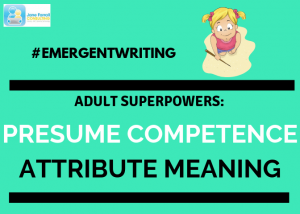It’s been a big time lapse (sorry!) – but this is the second of a series of blog posts about writing – and about assisting all students to become stronger writers.
So moving on from the very beginnings of writing, let’s move to talk about the next stage.
Early Emergent Writing: Moving onto Form
In the previous blog post, we followed Mathilda’s writing development as she learned more and more about how literacy works with an emphasis on her writing development. First, she learned that she was a writer, then she learned the functions of print through all her interactions with literacy – and this was all assisted by the adult superpowers of presuming competence and attributing meaning.
We followed Mathilda from 17 months of age to three years – and now let’s pick up again with that same video of a three year old Mathilde writing a card.
During the last blog post, I commented that Mathilda was starting at around 2.5 years to age to demonstrate that she understood that there was a difference between writing and drawing – and we can see that really clearly in this video. Her writing is now a series of wavy lines – whereas her drawing at the same time was a variety of shapes with an increasing range of detail.
This change has happened because of Mathilda’s overall literacy experiences. As adults have read books with her, she has noticed that there is a difference between writing and pictures. Adults have pointed out “letter-like” shapes in her writing, as her fabulous mother Yvette does in the video. She has seen adults writing – with pens and keyboards – and she has noticed the difference between that and drawing. All of these experiences together have helped her to recognise that there is a difference between writing and drawing and her own “writing” has then become more and more like the print we see everywhere in the world around us.
And those adult superpowers still make an important contribution. Every time an adult attributes meaning to Mathilda’s writing and assumes her competence it helps her confidence and to move her a little further with her writing development.

As Mathilda continues to write and learn about literacy overall, her writing will continue to change – and we will see more and more evidence of “form”. She will use more and more definite letter shapes, rather than wavy lines. There may be numbers as well as letters, and some “letter-like” shapes as well, but her writing will gradually move more and more into looking like letter strings.
The example below is a Father’s Day card and envelope from when Mathilda is 3 years and 9 months of age – and the front of the card shows her drawing while the envelope is a beautiful example of letter like strings.

Father’s Day Card

Envelope for the card
At some stage, after she is consistently writing letter strings, another change will take place, showing even more evidence of her awareness of the “form” of writing. Basically, we will see spaces and gaps appearing in her writing. Once again, this occurs as Mathilda develops her understanding of form. She realises that not only are there lines of letters in writing but also gaps in those lines – and these gaps then start to appear in her writing. This is not something she is has been sat down and taught – although we can make it easier for her to learn it by modelling it explicitly – but overall the use of spaces is a demonstration that a developing writer has learned enough about literacy to know that spaces are important – and therefore they start to include them.
Then, at around 5 years of age, Mathilda will write her first real word as part of her writing. It might be a standalone word or it might be included in a letter string, but she makes this final jump to form and we will know that she is now starting to move into being a conventional writer. And so, from 17 months of age to 5 years of age she has moved to understanding the functions of print, to developing the early stages of form. During this time she has had LOTS of literacy input – daily reading and writing accompanied by lots of interaction, play and observation of adults also engaged in literacy. It’s important to understand and remember that this development takes quite a period of time.
Emergent writing and students with disabilities
As I said in the previous blog post, this sequence of writing development has everything to do with EVERY emergent writer – including all students with disabilities. To quote myself (!) “in the history of special education we have tried to bypass emergent writing because we haven’t understood how important it is. Or, because we have mistakenly thought that because a student is school age that we should be making their writing “look appropriate”. When I first started working as a speech pathologist in special education settings, nearly 30 years ago, the majority of writing “instruction” was about copying. We had students copying who didn’t believe they were writers and who had never had an opportunity to scribble. We didn’t teach them about the functions of print – we just taught them to copy. We never taught them that print was a code for speech. We didn’t teach them those basic functions of print that allow individuals to develop as writers. At 2.5 years of age, Mathilda can generate an idea and some language and then “write” it. But those students never learned that ideas and language underlie all writing because all we taught them was how to copy. Their writing “looked” a lot more like writing than Mathilda’s – it had letters and words – but it wasn’t really writing. And we all knew that. So many students from that period only learned one thing about writing – which was that they were a failure at it.”
We now have over 10 years of implementing emergent writing with emergent readers and writers of all ages. We have figured out a whole range of alternative pencils that they can use so that we can give them the same emergent writing experiences that Mathilda got. We recognise that many students with disabilities need more emergent writing experiences to become writers – and we understand that if Mathilda takes over 3.5 years to develop from a very early emergent writer to an early conventional writer, that it may take some students with disabilities even longer. But instead of saying “they can’t” our job is to figure out how to get those experiences happening with every emergent writer at any age so that they can develop the same understandings and skills. So that every student can develop an understanding of those important, underlying functions of print and then move onto understanding more and more about form as a solid foundation for their writing development.
And stay tuned to the next blog post which is heading out to a much larger view of writing development through a writing data wall.
And, as always, I have to thank the Centre for Literacy and Disability Studies, Karen Erickson, David Koppenhaver and Sally Clendon for everything they have taught me. And an HUGE thank-you to Mathilda and her family for being so awesome.

